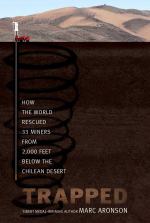
|
| Name: _________________________ | Period: ___________________ |
This test consists of 5 multiple choice questions, 5 short answer questions, and 10 short essay questions.
Multiple Choice Questions
1. In Chapter One: "August 5-6," what is the first alarming event that Raul Villegas experiences while driving in the mine?
(a) A sudden temperature drop.
(b) A strange crack.
(c) A loud explosion.
(d) A blinding flash of light.
2. In Chapter Four: August 5–8: “Murderers,” what conditions do the trapped miners face in the shelter?
(a) Frequent earthquakes and tremors.
(b) Flooding and waterlogged surroundings.
(c) Total darkness and high humidity.
(d) Extreme cold and freezing temperatures.
3. In Chapter Three: "The Men of Hephaistos," how does mining impact the living conditions in neighborhoods like Padre Negro outside Copiapó?
(a) Miners and their families experience a lack of basic amenities.
(b) Mining creates job opportunities and better housing.
(c) Mining has no direct impact on these neighborhoods.
(d) Mining leads to improved infrastructure and amenities.
4. In Chapter Two: "Of Earth and Cold," what geological phenomenon influenced the lack of rainfall along the Pacific coast, particularly in the Atacama Desert?
(a) Tectonic plate movement.
(b) Volcanic eruptions.
(c) Wind patterns.
(d) Solar radiation.
5. In Chapter Six: August 10-21: “Drilling Blind,” what is the timeline for the trapped miners' survival, as mentioned in the chapter?
(a) 10 days.
(b) 4 weeks.
(c) 2 weeks.
(d) 1 month.
Short Answer Questions
1. In Chapter Two: "Of Earth and Cold," what role does gravity play in mining operations?
2. In Chapter Six: August 10-21: “Drilling Blind,” what significant event in history is mentioned as a potential comparison to the miners' situation, although it is not openly discussed?
3. In Chapter Three: "The Men of Hephaistos," why was bronze considered a sacred metal during ancient times?
4. In Chapter One: "August 5-6," how can societies promote and embrace cultural diversity?
5. In Chapter One: "August 5-6," what challenges do the rescue team face during their mission in the mine?
Short Essay Questions
1. In Chapter Six: August 10-21: “Drilling Blind,” how does the presence of Kelvin Brown affect the families at the campsite?
2. In Chapter One: "August 5-6," describe the events that unfold in the Chilean copper mine as Raul Villegas drives his truck underground. What are the initial signs of trouble, and how does Villegas react?
3. In Chapter Five: August 8–10: “Hope,” what role does faith play in the narrative, and how is it symbolized in the chapter?
4. In Chapter Six: August 10-21: “Drilling Blind," what similar mining accident is mentioned in the chapter, and how does it relate to the situation of the Chilean miners?
5. In Chapter Three: "The Men of Hephaistos," explain the historical and cultural importance of copper and how it has been intertwined with human progress.
6. In Chapter One: "August 5-6," how do Villegas's superiors and colleagues respond to his reports of the strange events in the mine? What actions do they take, and what does this reveal about their initial perceptions of the situation?
7. In Chapter Five: August 8–10: “Hope,” how does Minister Golborne manage the dual responsibilities of overseeing the rescue efforts and addressing the emotional needs of the community?
8. In Chapter Six: August 10-21: “Drilling Blind,” what challenges does Kelvin Brown face in the early days of the rescue efforts?
9. In Chapter Two: "Of Earth and Cold," discuss the challenges miners face when working deep underground, as described in the chapter. What motivates individuals to pursue this profession despite the inherent risks?
10. In Chapter Four: August 5–8: “Murderers,” who are the key figures involved in the rescue efforts?
|
This section contains 1,266 words (approx. 5 pages at 300 words per page) |

|




